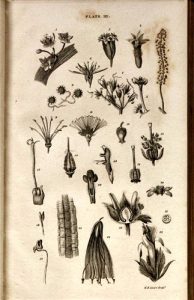The story of the last Passenger Pigeon and the disappearance of the Great Auk, Carolina Parakeet, and Heath Hen reveal the fragile connections between species and their environment. To help tell their story, the Smithsonian Libraries, Biodiversity Heritage Library, and the National Museum of Natural History have curated a joint exhibit entitled Once There Were Billions: Vanished Birds of North America which opened June 24 in the National Museum of Natural History.
Category: Natural and Physical Sciences
At this time of year, those of us in the U.S. often find our eyes turned skyward to admire a brilliant array of colors lighting up the night sky in celebration of America’s independence. Up until about a hundred years ago, a colorful display of another kind filled the North American skies, and not just on the fourth of July. Jewel-colored Carolina parakeets (Conuropsis carolinensis) traveled in huge, noisy flocks from southern New York and Wisconsin to the Gulf of Mexico, favoring old forests along rivers. Although they looked tropical, Carolina parakeets didn’t migrate south in the winter but weathered the cold.
The story of the last Passenger Pigeon and the disappearance of the Great Auk, Carolina Parakeet, and Heath Hen reveal the fragile connections between species and their environment. To help tell their story, the Smithsonian Libraries, Biodiversity Heritage Library, and the National Museum of Natural History have curated a joint exhibit entitled Once There Were Billions: Vanished Birds of North America which opened June 24 in the National Museum of Natural History. Over the next several weeks, we’ll be highlighting each of the four birds with content from the exhibition and illustrations from BHL.
Once an amazing diversity of birds-some in breathtaking abundance-inhabited the vast forests and plains of North America. But starting around 1600, some species began to disappear, as humans altered habitats, over-hunted, and introduced predators. A notable extinction occurred 100 years ago, with the death of Martha the Passenger Pigeon, the last member of a species that once filled America’s skies. The story of the last passenger pigeon, and the disappearance of the great auk, Carolina parakeet, and heath hen reveal the fragile connections between species and their environment. The Smithsonian Libraries unveils Once There Were Billions: Vanished Birds of North America at the National Museum of Natural History June 24. This exhibition is a joint production of Smithsonian Libraries, Biodiversity Heritage Library, and the National Museum of Natural History.
The Smithsonian Libraries invites you to:
Echoes of Their Wings: The Passenger Pigeon and its Legacy
The exhibition opening for “Once There Were Billions”, featuring a lecture and book signing by Joel Greenberg, author of A Feathered River Across the Sky: The Passenger Pigeon’s Flight to Extinction.
National Museum of Natural History
10th and Constitution Ave, NW
Washington, DC 20004
FREE & OPEN TO THE PUBLIC
Please RSVP to SILRSVP@si.edu or call 202-633-2241
Elements of the philosophy of plants by Augustin-Pyramus de Candolle and Kurt Sprengel is the first edition in English of a composite work by two of the most eminent botanists of the early 19th century. The first three parts on nomenclature, theory of classification, and descriptive botany are from a work by de Candolle, while the final part on the structure and nature of plants is by Sprengel. This book was recently adopted through our Adopt-a-Book program by George Gwynn Hill.
The Biodiversity Heritage Library (BHL), headquartered at the Smithsonian Libraries, welcomes Washington University Libraries (St. Louis, Missouri) as a new member. The 14th member of the BHL consortium, Washington University Libraries will help identify and digitize historical science literature from its collections and add these to the BHL’s online holdings, where all materials may be accessed free by the public.

